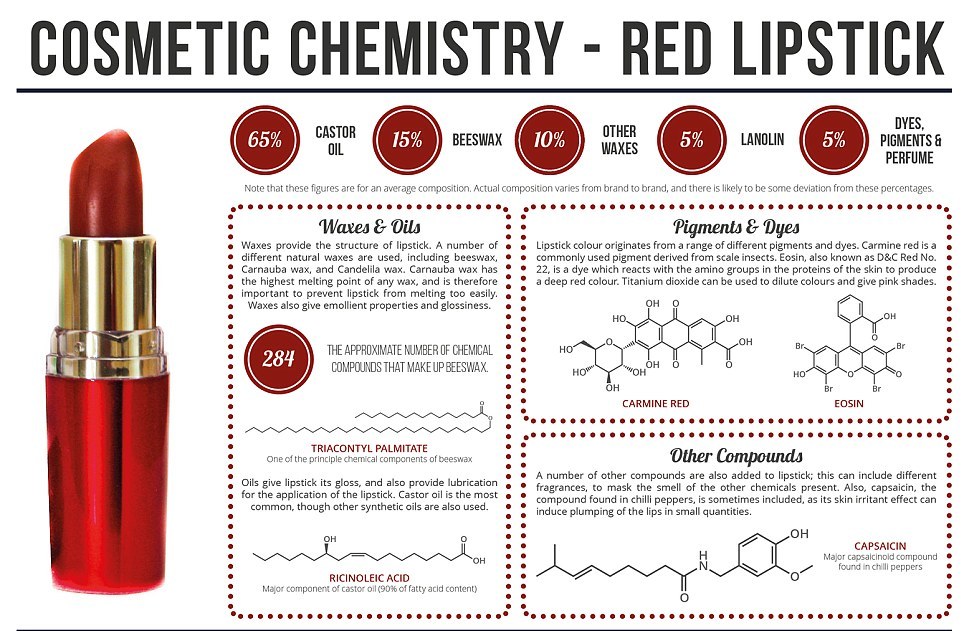A single lipstick contains several hundred different chemical compounds to give it the desired colour, glossiness, and indelibility.
And while ingredients will differ between brands, there are a number of essential ingredients, according to Bournemouth-based teacher Andy Brunning who is the author of the blog, Compound Interest.
The pigment used in red lipstick is often made from crushed cochineal bugs, which live on cacti.
The colour is known as Carmine red – or carminic acid – and is prepared by boiling the insect bodies in ammonia or sodium carbonate solution.
The mixture is then filtered before hydrated potassium aluminium sulphate is added.
Deep red lipsticks and formulas that claim to be long-lasting, often include a chemical compound called eosin.
The dye subtly changes colour when it is applied to the lips and produces a lipstick that has a slightly blue tinge.
The dye reacts with the amine groups found in proteins in the skin, and this reaction causes its colour to intensify to become a deeper red.
This reaction also makes the dye longer-lasting than others.
Other pigments and dyes – which only make up five per cent of a lipstick – are used for different colours.
Titanium dioxide, which is a white compound, is a common ingredient that is added to dilute red lipsticks and make them pink.
Other compounds can be added in small quantities to make formulas more moisturising or fragrant.
For example, capsaicin – a compound found in chillies – can act as a minor skin irritant, which causes the lips to swell slightly, plumping them up.
Waxes and oils make up the bulk of lipstick’s composition, with waxes crucial to the structure and shape of the lipstick.
Beeswax, which is composed of 300 different chemical compounds, is often used, while other natural alternatives include Candelilla wax from a Mexican shrub and lanolin, which is a substance secreted by the glands of sheep.
Carnauba wax – obtained from the Brazilian Carnauba Palm – makes a lipstick less likely to melt in the sun because it has the highest known melting point of any wax at 87˚C.
As well as keeping the lipstick in shape, the waxes also bind together other ingredients and can determine its glossiness.
Oils, such as castor oil, make up around 65 per cent of any lipstick and give the cosmetic its skin-softening properties, as well as making it glide onto the lips.
In recent years, there have been concerns about traces of heavy metals in lipsticks.
One study by the University of California, Berkeley, found that 32 brands of lipstick contained tiny amounts of lead, aluminium, chromium and manganese, but it was based on humans ingesting the lipstick and the levels consumed were considered to be safe.
Despite this, lots of cosmetics companies are careful to make their products lead-free.
INGREDIENTS FOR THE PERFECT POUT
Cochineal beetles provide the pigmentation for red lipsticks.
Eosin is used in vampy deep hues and makes lipsticks long-lasting.
Titanium dioxide is added to red pigment to produce sugary pink shades.
Capsaicin – a compound found in chillies – acts a minor skin irritant so it plumps up the lips.
Carnauba wax is included in lipsticks that are less likely to melt if they are left in a hot car.
Castor oil enables lipstick to glide onto the lips and affects its glossiness.



2 thoughts on “What’s really in your lipstick? From chillies to insects, the bizarre ingredients that give you the perfect pout”
In a related development, experts have found that 90% of ladies make-ups end in guys digestive tracks
That’s for obvious reason. Lol